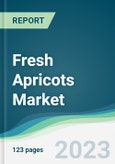The global fresh apricot market is projected to grow at a CAGR of 1.56%, reaching US$533.937 million in 2028 from US$479.234 million in 2021.
Fresh apricot is a type of stone fruit that is small, juicy, and predominantly yellow with a tarty taste. Apricots are packed with nutrients and add to a balanced diet. They are grown in temperate climates, such as the Mediterranean region. The fruit is frequently used as a liqueur flavoring agent and is extensively processed into jam.The high popularity of fresh apricots is attributed to the growing demand for healthy and convenient snacking solutions, especially amongst the younger generation. Nowadays, consumers prioritize their health and wellness and favor snacks and meals that will improve their well-being and give them a balanced diet. Moreover, the growing demand for organic, natural, and preservative-free products is also spurring the growth of fresh apricots among consumers. According to a study conducted by the CITFL, 98 percent of respondents like consuming fresh apricot because they are perfectly convenient and ready-to-eat snacks on the go. Fresh apricots are used in various desserts, beverages, and snacks, such as pies, cakes, pastries, puddings, ice creams, etc. Fresh apricots are rich in natural sugar and are a strong source of vitamin A, contributing to its high demand.
While the global market for fresh apricots is expected to grow during the projection period, high and volatile prices, stringent export and import laws, and a lack of knowledge will inhibit growth.
The health benefits and growing demand for healthy food products are augmenting the demand for fresh apricots.
The vitamins and minerals found in apricots are important to the health of our bodies. They are particularly abundant in dietary fiber, potassium, and vitamins A and C. One serving of apricots might be satisfactory and provide nearly 25 percent of a person's daily potassium requirements. Consumption of apricots help prevent cardiovascular disorders, improves digestion, lower blood sugar level, help in disposing of cellular waste, and improves eyesight.Busy lifestyles, demanding work schedules, and changing dietary preferences have increased consumers' propensity for healthy snacking options, particularly among millennials. They have changed their food preferences to plant-based foods that can offer health and flavor, driving the global market demand.
Organically sourced fresh apricots are witnessing huge demand.
Growing demand for organic, natural, nutritional, and pesticide-free products is driving the growth of this market. Consumer shift towards organic agriculture is also propelling the demand for organic fresh apricots. According to the latest FAO estimates, organic farming is conducted in 187 countries globally, and at least 3.1 million farmers used organic practices to manage 72.3 million hectares of agricultural land. Organic food and drink globally accounted for more than 106 billion euros in 2019.North America is anticipated to hold a significant share of the global fresh apricot market.
North American region is anticipated to hold a substantial market share in fresh apricot. This region will experience rapid expansion throughout the projection period due to the growing demand for healthy and convenient snacking solutions. According to the Food and Health survey conducted by the IFIC, studies show that one-third of Americans indulge in snacking at least once every day, and almost a quarter claim to do so numerous times each day. This region's market is also expanding due to the high demand for health, nutritional, and natural food products and beverages, along with the growing millennial population. According to the NASS data, in 2021, there were 41,740 tonnes of apricots produced in the United States, worth US$37 million. From 2020 to 2021, the tonnage increased by 10,330 tonnes. Fresh apricots were worth $27.6 million. Exports of fresh apricots from the United States in 2021 totaled 13.9 million pounds and were worth US$13 million. In 2021, Canada remained the top export destination for fresh apricots, paying approximately US$8,256. Mexico came in second with US$2,577. They are becoming more popular among people in this region due to rising health awareness of the fresh apricots machines, thereby fueling regional market expansion. In addition, the prevalence of key market players such as Dole Food, Ardo, Crop’s nv, Earthbound Farm, and others also spur the growth of fresh apricots in this region.Market Developments:
- In September 2022, the Indian Ministry of Commerce and Industry was working with stakeholders in the apricot value chain to increase export from Ladakh under the brand Ladakh Apricot to increase the export of agricultural and food goods from Ladakh. This initiative is being carried out through APEDA, the ministry's export promotion organization. The region's growth is anticipated to benefit from APEDA's efforts to promote the export of apricots and other agricultural goods.
Market Segmentation:
By Type
- Yellow Apricot
- Orange Apricot
- Red-Purple Apricot
- Others
By Nature
- Organic
- Conventional
By Geography
- North America
- United States
- Canada
- Mexico
- South America
- Brazil
- Argentina
- Others
- Europe
- United Kingdom
- Germany
- France
- Spain
- Others
- Middle East and Africa
- Saudi Arabia
- UAE
- Israel
- Others
- Asia Pacific
- Japan
- China
- India
- South Korea
- Indonesia
- Thailand
- Others
Table of Contents
Companies Mentioned
- Dole Food
- Ardo
- Crop’s NV
- Earthbound Farm
- Hain Celestial
- SunOpta
- SunPacific
- Welch’s Foods








